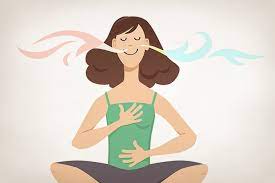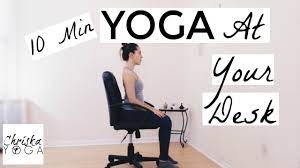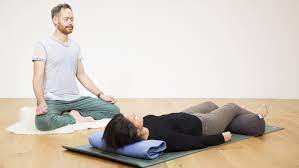Revitalize Your Life with These Quick Yoga Exercises
If you’re feeling low on energy, unmotivated, or just plain stressed out, it’s time to incorporate yoga into your daily routine. Not only is it a great way to get some exercise, but it can also help you relax, refocus, and revitalize your life. Here are some quick and simple yoga exercises that you can do anytime, anywhere to bring some balance and peace into your day. So take a deep breath, stretch those muscles, and let’s get started on your path to wellness!
Benefits of Yoga

Yoga is an ancient practice that has become increasingly popular in recent years. This is because it offers a range of physical, mental, and emotional benefits that can help improve your overall health and well-being.
Firstly, practicing yoga can help increase your flexibility and strength. The different yoga postures or asanas can help stretch and tone your muscles, making them more resilient and strong.
In addition, yoga can help improve your balance and coordination, which is essential for everyday activities such as walking, climbing stairs, and even standing upright.
But the benefits of yoga don’t stop there. Practicing yoga can also help calm your mind, reduce stress and anxiety, and improve your overall mood. This is because yoga involves controlled breathing techniques that can help slow down your heart rate and relax your nervous system.
Yoga has also been shown to improve your immune system and boost your overall energy levels. This means that you are less likely to get sick, and you’ll have more stamina and focus to tackle your daily tasks.
Lastly, yoga can help promote a sense of inner peace and well-being. By practicing yoga regularly, you’ll learn how to listen to your body, become more aware of your thoughts and emotions, and live a more mindful and present life.
In short, practicing yoga is a great way to revitalize your life and achieve a healthier, happier, and more balanced you.
Basic Yoga Exercises for Beginners

If you’re new to yoga, it can be overwhelming to know where to start. Here are some basic yoga exercises that are perfect for beginners:
- Mountain Pose (Tadasana)
Stand with your feet together, shoulders relaxed, and arms at your sides. Focus on your breath and your posture. Hold this pose for several breaths. - Child’s Pose (Balasana)
Sit back on your heels with your knees apart. Lean forward and stretch your arms out in front of you. Rest your forehead on the floor. Take several deep breaths. - Downward-Facing Dog (Adho Mukha Svanasana)
Start on your hands and knees, then lift your hips up and back, straightening your arms and legs. Aim to make an inverted “V” shape with your body. Hold for several breaths. - Warrior I (Virabhadrasana I)
From downward-facing dog, step one foot forward and place it between your hands. Rotate your back foot so it’s at a 45-degree angle. Lift your arms up overhead and look up at your hands. Hold for several breaths, then switch sides. - Triangle Pose (Trikonasana)
From Warrior I, straighten your front leg and reach forward with your front hand, then place it on your shin or the floor. Extend your other arm up and look up at your hand. Hold for several breaths, then switch sides.
Remember to listen to your body and take things slowly. It’s better to do a few poses correctly than to rush through many poses and risk injury. And don’t forget to breathe! Focusing on your breath is a key aspect of yoga.
Surya Namaskar or Sun Salutation

Surya Namaskar or Sun Salutation is a popular sequence of yoga poses that can help to energize your body, warm up your muscles, and increase flexibility. This set of exercises is an excellent way to start your day as it can help to clear your mind, increase focus, and uplift your mood.
The Sun Salutation sequence typically consists of 12 poses that are performed in a fluid and continuous motion, with each pose flowing seamlessly into the next. Each pose in the sequence has its unique benefits, including strengthening your muscles, increasing flexibility, improving digestion, and stimulating the immune system.
To practice Surya Namaskar, stand tall at the front of your mat with your feet together, arms by your side, and palms facing forward. As you inhale, raise your arms above your head and gaze up towards your hands. As you exhale, bend forward from the waist, bringing your hands to the floor.
Inhale and step your right foot back, bringing your right knee to the floor, and lift your chest and gaze towards the ceiling. As you exhale, step your left foot back into plank pose. Lower your knees to the floor, and lower your body down to the floor in a controlled manner, with your elbows hugging your sides.
Inhale and lift your chest into upward-facing dog, keeping your arms straight and shoulders relaxed. Exhale and lift your hips into downward-facing dog, with your feet hip-width apart and your hands shoulder-width apart. Hold this pose for a few breaths before returning to standing position and repeating the sequence, leading with your left foot this time.
By practicing Surya Namaskar daily, you can reap the numerous benefits of this dynamic yoga sequence, including increased strength, flexibility, and energy levels. So, start your day with a Sun Salutation sequence to revitalize your body, calm your mind, and uplift your spirit.
Pranayama or Breathing Exercises

Yoga is not just about physical exercises or poses, but also about deepening your breathing practices. Pranayama, or breathing exercises, is an essential component of yoga that can bring immense benefits to your mind and body.
Pranayama exercises involve deep, slow, and conscious breathing, allowing you to slow down and be more present in the moment. Regular practice of pranayama can improve your lung capacity, lower stress levels, boost your immunity, and improve overall health and well-being.
Here are some simple pranayama exercises you can practice on your own:
- Ujjayi Breathing: Also known as “ocean breath,” this technique involves breathing in and out through your nose, while constricting the muscles at the back of your throat. This creates a soft hissing sound, resembling the sound of ocean waves. This technique can help calm your mind, and is particularly useful for reducing anxiety and stress.
- Nadi Shodhana Pranayama: Also called “alternate nostril breathing,” this technique involves inhaling through one nostril while closing the other nostril with your finger. Then exhaling through the other nostril while keeping the other nostril closed. This practice can help balance your nervous system, promote mental clarity, and reduce anxiety.
- Kapalbhati Pranayama: This technique involves short, quick exhales while keeping your inhalations slow and controlled. This practice can help cleanse your lungs, improve digestion, and boost your metabolism.
Incorporating pranayama into your yoga practice can bring a new dimension to your routine, and help you achieve a deeper level of relaxation and mindfulness. Practice these techniques regularly, and notice how your mind and body begin to feel revitalized and refreshed.
Chair Yoga Exercises for Office Workers

Working in an office can take a toll on your body. Sitting for long hours can lead to back pain, neck stiffness, and poor posture. However, with chair yoga exercises, you can stretch and strengthen your muscles without even leaving your desk.
Here are some simple chair yoga exercises that you can try:
- Seated Cat-Cow Stretch:
Sit with your feet flat on the ground and your hands on your knees. Inhale and arch your back while looking up towards the ceiling. Exhale and round your spine while looking down towards your navel. Repeat this motion 5-10 times. - Seated Pigeon Pose:
Cross your right ankle over your left thigh and flex your right foot. Sit up straight and hold for 30 seconds. Switch legs and repeat. - Seated Twist:
Sit up straight and cross your right hand over to the outside of your left knee. Use your left hand to hold onto the back of the chair. Inhale and lengthen your spine, exhale and twist to the left. Hold for 5-10 breaths and repeat on the other side. - Seated Forward Fold:
Sit with your feet flat on the ground and your hands on your knees. Inhale and lengthen your spine, exhale and fold forward with a straight back. Reach your hands towards your feet or ankles and hold for 30 seconds. - Wrist Stretch:
Hold your arms out in front of you with your palms facing down. Slowly bend your wrists so that your fingers are pointing towards the floor. Hold for 5-10 seconds and then repeat with your palms facing up.
Incorporate these chair yoga exercises into your daily routine to reduce stress and tension, improve posture, and increase energy levels. Taking care of your body is important for overall health and wellness. Give yourself a break from the demands of the workday and try these exercises for a quick and revitalizing boost.
Relaxation Techniques through Yoga Nidra

In today’s fast-paced world, relaxation techniques are crucial to maintain physical and mental well-being. Yoga Nidra is a powerful relaxation technique that can help you attain a deep state of relaxation by relaxing every part of your body. This technique involves lying down comfortably while the instructor guides you through a series of steps.
Yoga Nidra is derived from the ancient yoga practice of yoga nidra, which means “yogic sleep.” This practice is designed to help you achieve a state of consciousness that is between sleep and wakefulness, which can help reduce stress and anxiety, and promote overall well-being.
The practice of Yoga Nidra involves lying down in a comfortable position with your eyes closed. The instructor will then guide you through a series of steps to help you relax and release tension in your body. These steps include body awareness, breathing exercises, visualization, and deep relaxation.
The benefits of Yoga Nidra include deep relaxation, reduced stress and anxiety, improved sleep, increased self-awareness, and enhanced creativity and productivity. This technique can be practiced by anyone, regardless of age, fitness level, or physical limitations.
If you’re interested in trying Yoga Nidra, there are many resources available online. You can find guided meditations and videos that will walk you through the practice. Alternatively, you can find a local yoga studio that offers Yoga Nidra classes.
Yoga Poses to Relieve Stress and Anxiety

Yoga is a wonderful practice for overall health and well-being, but did you know that it can also help relieve stress and anxiety? By incorporating specific yoga poses into your daily routine, you can reduce feelings of tension, calm your mind, and bring a sense of peace and relaxation to your body. Here are a few poses that are especially effective for stress relief:
- Child’s Pose: This is a gentle pose that stretches the hips, thighs, and ankles, while also promoting deep relaxation and mental calmness. To do this pose, kneel on the floor with your big toes touching and sit back on your heels. Slowly lower your torso down and rest your forehead on the floor. Extend your arms forward or rest them by your sides. Breathe deeply and hold for several breaths.
- Standing Forward Bend: This pose is great for relieving tension in the back, neck, and shoulders, while also calming the mind and promoting relaxation. To do this pose, stand with your feet hip-width apart and hinge forward from your hips. Reach your hands towards the floor or hold onto your elbows. Allow your head to hang heavy and breathe deeply.
- Legs Up the Wall: This is a restorative pose that promotes deep relaxation and helps to calm the nervous system. To do this pose, lie on your back with your legs up against a wall. Your hips should be as close to the wall as possible. Relax your arms by your sides or rest them on your belly. Close your eyes and breathe deeply.
- Cat-Cow Pose: This gentle flow is great for releasing tension in the spine and promoting mental focus and clarity. Start on your hands and knees with your wrists directly under your shoulders and your knees directly under your hips. Inhale and arch your back, lifting your head and tailbone towards the ceiling. Exhale and round your spine, bringing your chin to your chest and tucking your tailbone under. Repeat several times, moving with your breath.
By incorporating these yoga poses into your daily routine, you can find relief from stress and anxiety, promoting relaxation and mental calmness. Try to practice these poses for at least 5-10 minutes each day, focusing on deep breathing and allowing yourself to relax fully into each pose. With regular practice, you will feel more centered, focused, and relaxed in your daily life.
